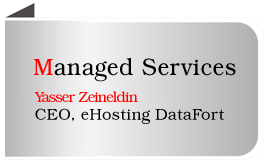

1. What is the current state of the managed services market in the Middle East?
The Managed Services market is growing strongly in the region - Traditionally, large businesses have been relying on the expertise and services of managed hosting providers to offer secure, flexible and scalable solutions. However, over the last few years we have been seeing a growing trend amongst SMEs choosing to work with service providers for their data centre requirements - a large part of which is due to the cost effectiveness that managed services offer.
The UAE continues to dominate the Managed Services market in the GCC. Data center hosting makes up approximately 18 per cent of the Managed Services market revenue in the UAE.
2. How will that change over the next few years?
The UAE continues to dominate the Managed Services market in the GCC and is expected to grow at a compound annual growth rate (CAGR) of around 17 per cent over the next five years, this is up from 12.9 per cent in 2011 - the acceleration is due in large part to increasing demand from core growth industries such as retail, healthcare, and manufacturing.
A more mainstream adoption of cloud computing will also be a driving factor likely to increase migration to managed services by small and medium businesses. Also, demand for virtualization, business continuity, and disaster recovery are expected to fuel growth.
3. Why are enterprises turning to managed service IT models?
Managed IT Services offer multiple benefits - at the strategic, operational and financial level. At the strategic level, managed IT services allow companies to focus and leverage their resources towards their core business activities, rather than spending too much time on operational activities. At the operational level, Managed IT Services offers the skills and expertise of a service provider to competently manage complex data centre requirements. At the financial level, Managed Services reduce total cost of ownership and provide the benefit of a subscription based OPEX model.
This means that enterprises can continue to focus on their strategic business objectives; relocate funds on developing new applications and innovation; and indirectly win access to skilled resources, latest technology and best-in-class infrastructure.
4. What are the main commercial benefits involved in turning to managed services?
- Reduced Total Cost of Ownership (TCO)
- Convert CAPEX to OPEX
- Predictable monthly expenses
- Reduced risks
- Overall minimized technology investment
5. What are the most popular managed services and why?
Managed Exchange, Managed Backup & Restore, Managed Storage and Managed Security Services are the some of the most popular managed services. With the constantly changing threat landscape, security is becoming critical, so we are seeing a lot of demand for Managed Security services. E-mail has become one of the most critical business applications forming the backbone for the day-to-day business operations. Anytime, anywhere access to e-mail, contacts, calendar and resources has become imperative to ensure effective communication with customers, vendors and partners. Managed Exchange is therefore becoming very popular.
6. How can CIOs both prove and measure ROI by adopting a managed service model?
There are a number of benefits that a managed services model offers which can help CIOs measure ROI.
These include:
- Converting CAPEX to OPEX and reduced Total Cost of Ownership (TCO)
- Minimizing technology investment
- Access to skilled resources without having to spend on continuously hiring and training IT staff.
- Access to state-of-the-art infrastructure without having to build
- Upgrading infrastructure very fast without having to worry about buying, deploying, maintaining, etc.
- 24/7 Service Desk access
- Guaranteed SLAs which provide a high quality of service
7. To what extent is managed services the future of enterprise IT in the Middle East?
More and more customers from a number of industry verticals are adopting Managed IT services. Sectors in Banking and Finance, Aviation, Media, Government, IT and Telecom in particular, have taken to managed services as ensuring a secure and reliable system is critical.
Furthermore, we are seeing growing interest in cloud computing. This growing adoption is a first step toward moving to a cloud-based model, as companies become more comfortable with the concept of on demand, dynamic and scalable IT services.
8. What are the risks and challenges involved when outsourcing functions to a managed model?
With a detailed service provider selection process, there are no risks when outsourcing to a managed model.
To maximize the benefits of a managed services model, there are certain key considerations that an organization should look at while selecting the managed services provider:
These include:
- Evaluate the credibility of the service provider.
- Check the Service provider has good customer references.
- Ensure it provides a guaranteed level of services offering high-end SLAs.
- Conduct a Site Visit + due diligence of Service Providers IT infrastructure.
- Ensure the Service Provider meets the specific needs of the nature and size of your company.
- Service Provider offers 24/7/365 support - ability to reach them during non working hours.
For example, at eHDF we provide round-the-clock monitoring and management of the IT infrastructure and comprehensive customized managed services all with a guaranteed service level agreement that meets international industry standards. With Accreditations in Assurance and Best Practices, eHDF is amongst one of the few Service Providers in the world to have obtained the prestigious ISO 9001, ISO 20000, ISO 27001, ISO 14001, ISO 18000, BS25999 and ITIL certifications.
